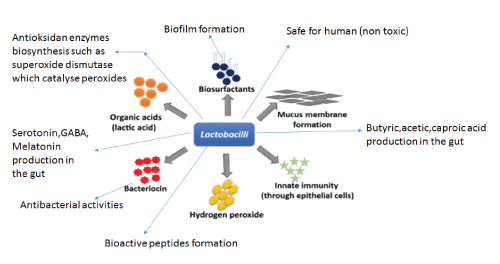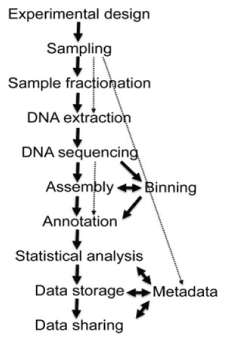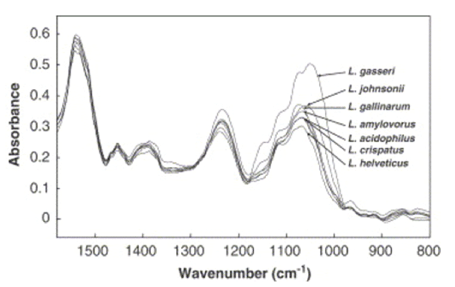Probiotic Lactobacillus helveticus Strain Identification, Characterization and Use in Clinical Practice
Fatih Y?ld?z1*
1Mogan International Research Center, Department of Food Engineering, Middle East Technical University Ankara, Turkey.
*Corresponding Author:Fatih Y?ld?z, Mogan International Research Center, Department of Food Engineering, Middle East Technical University Ankara, Turkey, Tel: +90 (312) 210 56 43; Fax: +90 (312) 210 27 67; E-mail: fatih@metu.edu.tr
Citation: Fatih Y?ld?z (2020) Probiotic Lactobacillus helveticus Strain Identification, Characterization and Use in Clinical Practice. Diabetes Cholest metabol 4: 119.
Copyright: © 2020 Fatih Y?ld?z, et al. This is an open-access article distributed under the terms of the Creative Commons Attribution License, which permits unrestricted use, distribution, and reproduction in any medium, provided the original author and source are credited.
Received: April 03, 2020; Accepted: April 10, 2020; Published: April 14, 2020.
Functions and Definition of Probiotics
Probiotics are live microorganisms that, when administered in adequate amounts, confer a health benefit on the host [1]. Health benefits provided by the whole bacteria, their cell wall structures or dead cells. The beneficial effects attributed to probiotic bacteria are often considered strain specific and have been proposed to at least involve cell surface components, including Peptidoglycan, Teichoic acids, Glycoproteins, and Polysaccharides [2].
Lactobacillus helveticus strains
There are more than 250 strains of the L.helveticus in the literature. Strain characterization and clinical evidence is required for EFSA, FDA and FOSHU health claims for probiotics. Probiotics are sold as dietary supplements, which do not require FDA approval before they are marketed. Lactobacillus species are used as probiotic, due to; -Gram positive, -nonperforming, -nonmotile rods (0.7-0.9 to 6.0 µm), occur singly or in chains. -microaerophilic, -catalase + bacteria, -probiotic characterization due to higher cell surface charge and hydrophobicity to epithelial surfaces.
Probiotic properties of Lactic acid bacterial species include the following tests and more;
pH tolerance test (pH 2, 2.5, 3, 4, 5, 8, and 9), Bile tolerance test (0.05%, 0.1%, 0.15%, 0.2%, and 0.3%). The measurement of antimicrobial activities to pathogens (Escherichia coli and Enterobacter spp.) tests. Cytochrome oxidase production + Production of Acid from Lactose as Lactic acid (Obligately homofermententativeglucose fermented to lactic acid 85% or more) Production of Gas(CO2) from Lactose (some strains) Maximum growth temperature 50-52 0C (optimum 30- 40 C) Probiotic attributes of L.helveticus strains. Figure 1. L.helveticus strain DPC4571 genome identifications. Figure 2. Table 1
Figure 1

Figure 2:

Table 1: Comparison and genomic characterization of L.helveticus strains [3].
|
Strains |
FAM8105 |
FAM22155 |
FAM8627 |
|
No.of Chromosomes/rRNA/tRNA |
1 / 12 / 61 |
1 / 12 / 62 |
1 / 7/ 61 |
|
Length |
2,209,387 bp |
2,191,149 bp |
2,035,631 bp |
|
GC Content |
37.1% | 37.1% | 37.0% |
|
Total no.of Genes/No. of proteins(and enzymes) |
2,217/1,876 |
2,178/1849 |
2,057/1691 |
| No.of Plasmids |
1 |
1 |
1 |
|
Length of plasmid |
45,858 bp |
7,514 bp |
13,399 bp |
|
GC Content of plasmid |
34.2% | 35.1bp | 34.8bp |
|
Total genes/all coding protein(and enzymes) of plasmid |
43 |
10 |
14 |
The use of 16S rRNA gene sequences to study bacterial phylogeny and taxonomy
The reasons for selection of 16S rRNA as biomarker include; (i) its presence in almost all bacteria, often existing as a multigene family, or operons; (ii) the function of the 16S rRNA gene over time has not changed, suggesting that random sequence changes are a more accurate measure of time (evolution); and (iii) the 16S rRNA gene (1,500 bp) is large enough for informatics and comparison purposes.The 16S rDNA sequences of L.acidophilus and helveticus bacteria phylogenetically differ by just 1.6%.
Studies of the 16S rRNA gene
After the DNA extraction, 16S rDNAs were ampli?ed from all of the L. helveticus isolates, and fragments that were approximately 1,500 bp long and were consistent with the 16S rRNA genes were obtained. 16S rRNA gene sequence determination and analysis. Ampli?ed 16S rDNA fragments from L. helveticus strains were sequenced directly by using a Taq dRhodamine terminator cycle sequencing kit (MicroSeq 16S rRNA gene kit; Perkin-Elmer Applied Biosystems, Foster City, Calif.) as recommended by the manufacturer. rRNA gene hybridization (ribotyping) and Cluster analysis can be done on PCR ampli?ed 388-bp fragments
Shotgun Metagenome sequencing for rapid identification of species and strains
Metagenomics is the study of all genetic material from all organisms in a definedsample. Figure 3. Identification of seven species of the Lactobacillus by FT–IR spectroscopy [4]. Figure 4.
Figure 3

Figure 4

Biochemical and physiolgical Functions of L.helveticus strains (Postbiotics)
Intracellular esterase of L. helveticus, starts lipolysis of fatty foods in the gut which produces; soluble short chain acetic, butyric and caproic acids. Dipeptidase activity, peptide hydrolase systems of L. helveticus degrade proteins to many functional peptides(decapeptide),amino acids. Fermentation of lactose, produces D and L lactic acids,lactones.
Bacterial autolysis in gut results from the enzymatic degradation of the cell wall peptidoglycan by endogenous peptidoglycan hydrolases named autolysins and it occurs within the cell. It also converts peptides and fats into desirable postbioticcompounds.After the initial breakdown of proteins by endogenous proteases and a set of peptidases is able to degrade the resulting peptides into free amino acids. L. helveticus DPC4571 is one of the highly autolytic strain and its genome sequence revealed the presence of putative lysin genes including autolysin amidases.
Probiotic potential of L. Helveticus strains
- possesses many common probiotic properties, such as the ability to survive gastrointestinal transit, adhere to epithelial cells, and antagonize pathogens. could prevent gastrointestinal infections, modulate host immune responses, and affect the composition of the intestinal microbiota. speci?c enzymatic activities of L. helveticus could indirectly bene?t the human host by enhancing the bioavailability of nutrients(such as Ca), removing allergens and other undesired molecules from food,and producing bioactive peptides through the digestion of food proteins.
Clinical importance and use of probiotics: Evidence of Probiotic effectiveness, Probiotics for Newborns and Children. How probiotics reduce the duration of diarrhea, Oral probiotics in influenza, Bacterial Gastroenteritis, Helicobacter pylori Infections and Complications, In?ammatory Diseases and Bowel Syndromes. Cancers, Mucosal Immunity and Allergy.
Clinical potential use of L.helveticus strains as probiotic: Peptide hydrolase systems of L. helveticus degrade proteins to many functional peptides(decapeptide),and amino acids. All these proteolytic properties leads to the following health benefits. improves mood and cognitive functions in human, improves anxiety-like behavior and memory, decreases stress levels, including depression, shown in laboratory experiments. Improve Cognitive Function in humans, improve sleep efficiency(decapeptides). L. helveticus produces angiotensin-converting enzyme (ACE)-inhibitory peptides (ACE)-inhibitory peptides, can prevent or control high blood pressure. Reduces elevatedblood pressure without any adverse effects. Long-term treatment with L. helveticus-fermented milk reduces arterial stiffness.
- containing cheese exhibits immunoregulatory actions, including an increase in regulatory T cell population and reduction in proinflammatory cytokines in test animals. As a result, L. helveticus can enhance specific and non-specific immunity. Clinical observations indicate that; L. helveticus supplementation significantly shortened the duration and decreased the number of symptoms of upper respiratory tract illness.
Bone and Mucsle Health
- increased blood calcium level in volunteers, and postmenopausal women. Lactic acid increases Ca absoption. Bioactive components increase bone formation, and prevented bone loss by decreasing bone turnover and increasing the bone mineral density in test animal studies. L. helveticus is protective against colitis and increases anti-inflammatory cytokine IL-10 in human peripheral blood mono-nuclear cells (PBMCs), thus Reduce Inflammation strongly alleviate symptoms of arthritis.
GI tract and probiotic L.helveticus
- can positively affect the host microbiota composition. In laboratory studies, the administration of L. helveticus increased the levels of total Lactobacilli and decreased total enterobacteria and sulfur-reducing clostridia in the gut thus preventing dysbiosis. a significant increase in butyrate, beneficial for gut homeostasis. L. helveticus alone or in combination with S. thermophilus effectively reduces the antigenicity of α-lactalbumin and β-lactoglobulin, the major allergens in cow’s milk. L. helveticus can significantly degrade the major allergens in propolis, including esters of caffeic acid.
Antibacterial and anticancer activities of L.helveticus
- shifts vaginal microflora and inhibits vulvovaginal candidiasis. Lactobacillus helveticus supplementation reduces upper respiratory infections. L. helveticus has a high ability to inactivate heterocyclic aromatic amines (HACs), the most abundant mutagens in fried red meat. L. helveticus inhibit the proliferation of human gastric cancer cells, human colon cancer cells, and liver carcinoma cells.
Bacteriocins produced by L.helveticus: Lacticin 481 (Carminati et al (1989), Lactocin 27, (Upreti and Hinsdill (1973), Helveticin J, (Joerger and Klaenhammer 1986), Bac, Lactacin B Probiotic bacteria produce organic acids, hydrogen peroxide, bacteriocin and antimicrobial compounds which may exhibit either bactericidal or bacteriostatic action.
References
- FAO/WHO. 2002. Guidelines for the evaluation of probiotics in food. Report of a joint FAO/WHO working group on drafting guidelines for the evaluation of probiotics in food. FAO/WHO, London, ON, Canada.
- Kleerebezem M, Hols P, Bernard E, RolainT, Zhou M, et al. (2010). The extracellular biology of the lactobacilli.FEMS. Microbiol Rev34:199-230.
- Front. Microbiol., 30 January 2018 | https://doi.org/10.3389/fmicb.2018.00063
- LWT - Food Science and Technology (2006) 39: 152-15.
